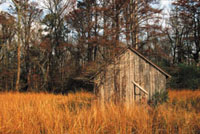The Hasselblad Xpan
Love At First Sight
Miles Davis, the jazz great, would say, "When you see something that you can do, you know it right away." It follows that my love affair with the Hasselblad Xpan was love at first sight, or actually love at second sight. I was briefly introduced to the Xpan while teaching a class at the M.A.R.S. school in Cape May, New Jersey. A student was trying to get my attention to show me this new camera, but I was so focused on teaching and getting to everyone in the field, that I blew it off, then just forgot about it. Later at the Shutterbug Trade Show and Convention in Baltimore, I was visiting the Hasselblad booth and vaguely remembered the Xpan and wanted to have a closer look. After getting a brief intro to it from Karen Hart of Hasselblad, I picked it up and it just felt great! After looking through the 45mm lens, which comes with the kit, the format just knocked me out and I had to have one! Now I have two! One is dedicated to Fuji Velvia transparency film and the second is dedicated to infrared and other various print films. Rangefinder Panoramic Three Lenses Available Exposure Tips Panoramic Vision Panoramic Prints Xpan Profile |
|||||
45mm f/4 Lens, 49mm Filter Size This is the first image I made with the Xpan using the 45mm. Otter Cliffs just seemed like a natural Xpan shot, with the long diagonal line cutting across the frame, the huge boulders, and great perspective. This is definitely a pan-enhanced image! This is one of those images that just fit in the 45mm picture space. I had to split the frame in half, normally not good composition, in order to minimize the white sky showing behind the trees. If I had pointed the camera any further upward, the white would have been a distraction. The 30mm lens would have included too much sky. Pointing the camera downward to include more of the grass would have placed the house too far up in the frame and was not seriously considered as a compositional option. Also, notice the light change that occurred while changing camera bodies from the Nikon F5 to the Hasselblad Xpan. |
|||||
90mm f/4 Lens, 49mm Filter
Size |
|||||
30mm Lens |
|||||
This is one of my favorite
pan-enhanced subjects. It's perfect for the 30mm lens. We had a
great dawn at low tide creating the wet sand reflection. There is light
falloff at the edges of all extreme wide angle lenses. Without the reflection
to brighten the bottom edges of the image, the light falloff using a lens
this wide would have made the foreground too dark. You can see some of
the effect at the lower edges. I composed this with the end pilings almost
touching the edge of the frame. On the finished slide, you can see how
much room was added. Knowing how much room to leave or how tightly to
crop an image is gauged through experience. You'll see quickly how
what you saw in the finder isn't how the image shows up on film.
The composition adjustment will happen quickly. |










































